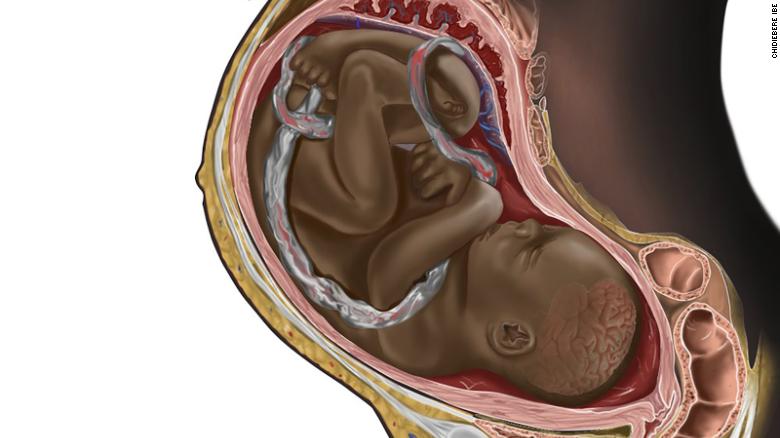Illustration of black fetus created to represent greater diversity 1:08
(CNN) -
At first glance, the image looks like a standard illustration that could easily be found on the pages of a medical textbook or on the walls of a doctor's office.
But what distinguishes the illustration of a fetus in the womb that has recently captured the attention of the Internet is a simple, but crucial detail: its dark skin tone.
The image, created by Nigerian medical student and illustrator Chidiebere Ibe, has struck a chord with countless people on social media, many of whom said they had never seen an illustration of a black fetus or a pregnant black woman before.
He also drew attention to a bigger problem: the lack of diversity in medical illustrations.
An image of a black fetus in a womb by illustrator Chidiebere Ibe recently caught the attention of the internet, with many people pointing out that they had never seen dark skin in such images.
(Although most fetuses are red - newborns appear dark pink or red and only gradually develop the skin tone they will have for life - the medical illustration is intended to represent patients who are not used to see your skin tone in these types of images).
Ibe said in an interview with HuffPost UK that she didn't expect to receive such an overwhelming response - her illustration of the fetus was one of many images she has created as a medical illustrator, most of which depict black skin tones.
But he underscored the importance of a mission to which he has been committed for a long time.
"The goal was to keep talking about what I am passionate about: fairness in health care, and also to show the beauty of blacks," he told the publication.
"We don't just need more representation like this: we need more people willing to create a representation like this."
advertising
CNN contacted Ibe to ask for a comment, but did not elaborate on the matter.
Ni-Ka Ford, chair of the diversity commission for the Association of Medical Illustrators, said the organization was grateful for Ibe's illustration.
"In addition to the importance of the representation of black and brown bodies in medical illustration, its illustration also serves to combat another great flaw in the medical system, which is the staggering and disproportionate maternal mortality rate of black women in this country." he wrote in an email to CNN.
Just over 40 years ago, the first cases of AIDS were registered in the United States
What is medical illustration
Medical illustrations have been used for thousands of years to record and communicate procedures, pathologies, and other aspects of medical knowledge, from the ancient Egyptians to Leonardo da Vinci. Science and art combine to translate complex information into images that can communicate concepts to students, professionals, and the public. These images are used not only in textbooks and scientific journals, but also in films, presentations, and other media.
According to the Association of Medical Illustrators, there are less than 2,000 trained medical illustrators in the world.
With only a handful of accredited medical illustration programs in America, which are often expensive and admit few students, the field has historically been dominated by white males, which, in turn, means that the bodies depicted tend to be as well.
"Historically [medical illustrations] have always featured non-disabled white male figures, and they still do today," says Ford.
"Bias towards one body type in medical illustration marginalizes all others."
Studies have supported this lack of diversity.
Researchers at the University of Wollogong in Australia found in a 2014 study that, of more than 6,000 images with identifiable sex in 17 anatomy textbooks published between 2008 and 2013, only 36% of the bodies depicted were female. .
The vast majority were white.
About 3% of the images analyzed showed disabled bodies, while only 2% featured older people.
The oximeter is crucial in the fight against covid-19 (but it may not work well in people with dark skin)
Why is diversity important in this field?
Diversity in the field of medical illustrations (or lack thereof) matters because these images can have implications for medical students, professionals, and patients.
"Without fair representation and without the perpetual use of white patients in medical textbooks, medical professionals are limited in their ability to accurately diagnose and treat people who do not fit that mold," he said Ford.
"Medical professionals may then tend to rely on racial stereotypes and generalizations due to this lack of knowledge about how symptoms present differently in darker skin tones, leading to worse care."
A study by the same Wollogong University researchers published in 2018 found that gender-biased images from anatomy textbooks increased medical students' scores on tests of implicit bias. Another study published in the journal
Plastic and Reconstructive Surgery Global Open
in 2019 found that white patients were overrepresented in images in plastic surgery journals, which the authors suggested could potentially influence the care non-white patients receive.
"For decades, peer-reviewed scholarly publications have used photographs and images that inappropriately portray the diverse demographics of patients affected by particular diseases," the researchers wrote.
"This is especially striking in the lack of diversity in medical illustration. These inequalities in medical information can have lasting downstream effects on the accessibility and delivery of healthcare."
"Racial Bias Runs Deep" at America's Largest Banks, Study Finds
Ford noted that those who are not typically featured in medical illustrations "may feel left out and unrecognized in a healthcare setting, leading to feelings of mistrust and isolation when receiving care." He also said that medical professionals may feel less empathy for groups that are not represented: black, brown, female, transgender or non-binary people, which can lower the quality of care they receive.
Inequalities in health care are well documented, and studies show that black patients are more prone to prejudice and misdiagnosis of certain diseases.
Research has also shown that a significant portion of white medical students and residents have false notions about biological differences between blacks and whites, which can lead to racial bias in the way they perceive and treat their pain.
Despite the persistent need for medical illustrations to represent the full spectrum of human diversity, the field is beginning to see change, medical illustrator Hillary Wilson told CNN.
Wilson, whose illustrations show black people in infographics about eczema, sun damage, alopecia and other conditions, said patients and professionals alike could benefit from seeing diversity represented in medical illustrations.
And through his work, he tries to humanize people of color and other marginalized groups by doing just that.
"The reality is that there are many different types of people," he said.
"For me, a resource is not complete if I do not at least take it into account and make an effort to take into account the fact that there are so many different types of people."
Although Ibe's image of the black fetus seemed to deviate from the norm, Wilson said he hopes that in the future, seeing black skin tones in medical illustrations will become routine.
"Over time, I hope it becomes one of the expected things," he added.
Fetus illustrations









